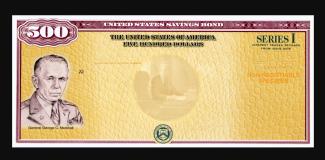
I Bonds: A Good but Limited Alternative to CDs
One of the great things about being a flat fee advisor is that it removes the incentive to gather all our clients’ financial assets into accounts that we manage. When we see a good opportunity outside of our wheelhouse, we do not hesitate to bring it to your attention. In this case, the opportunity is to earn a safe annual 7.12% return over a six-month period (i.e., earn a total return of 3.56% over six months).
The vehicle that accomplishes this feat is the Series I savings bond (I bond) issued by the U.S. Treasury but only through TreasuryDirect. You cannot buy these bonds in a brokerage account. I-bonds are like TIPS (Treasury Inflation-Protected Securities) in offering protection against inflation, but there is a very important difference. The inflation component of the I-bond interest rate on newly purchased bonds is based on inflation that has already occurred. It almost sounds too good to be true. Since the Consumer Price Index (CPI) increased by 3.56% for the six months ending 9/30/21, the offered annual interest rate for I-bonds purchased through 4/30/22 is 7.12% (again, 3.56% over a six-month period). For TIPS, the inflation adjustment is based on the CPI increase that occurred while you held the bond. Another important difference is that TIPS are currently priced to have a negative pre-inflation yield while newly issued I bonds have no deduction from inflation.
Now for the downsides. First the limit on purchases through TreasuryDirect is $10k per calendar year per person. This means that a married couple can buy $20k before 12/31/21 and another $20k between 1/1/22 and 4/30/22. But wait, there’s more! If you have a tax refund, you can use up to $5k of it to buy I-bonds in paper form (see the image above). Regarding taxation, as with other Treasury bonds, the interest is federally taxable but normally exempt from state and local taxes. However, federal taxes can be deferred to maturity or when the bond is cashed in. Also, under certain circumstances, the interest can be tax-exempt if used for qualified higher education expenses. Unfortunately, IRAs cannot be held with TreasuryDirect.
Second, you can cash out your bonds after a year, but you’ll lose three months of interest if you cash out before holding them for five years. Beyond the five years, they continue to earn interest for up to thirty years, compounded semi-annually with the rate reset every six months.
Third, if or when inflation returns to pre-Covid levels, the credited interest rate may become lower than the rates available on CDs and other safe bonds. Another savings bond worthy of consideration is the Series EE which has the same purchase limits as I bonds. Uncle Sam guarantees that you will double your money if you hold EE bonds for 20 years. This equates to an annualized return of 3.53%, which is a bit better than the 1.99% yield-to-maturity on 20-year Treasury bonds (according to Treasury.gov as of 11/12/21).
As you may have inferred, I bonds make great gifts which can be facilitated through TreasuryDirect. They can be bought in denominations as low as $25. If you have any questions about savings bonds, please do not hesitate to reach out.

